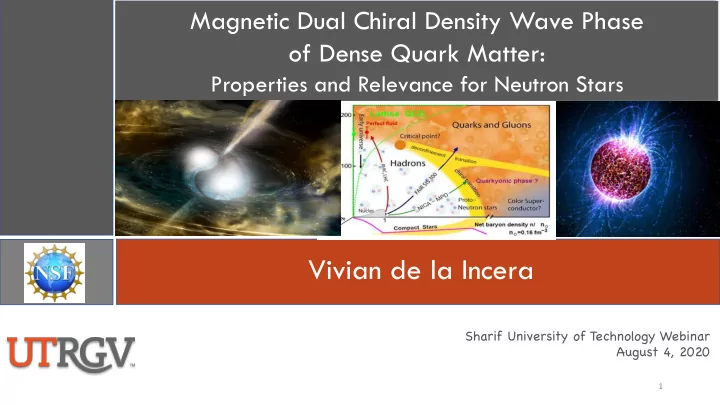

Magnetic Dual Chiral Density Wave Phase of Dense Quark Matter: Properties and Relevance for Neutron Stars Vivian de la Incera Sharif University of Technology Webinar August 4, 2020 1
Outline 1. Why Quark Matter? 2.Why Inhomogeneous? 3.Basics of the MDCDW Phase 4.MDCDW: a Prospect for NS Core Phases 2
Matter under Extreme Conditions 3
1. Why a Quark Matter Phase? 4
Composition of Matter in NS 5
Range of Allowed NS EoS Obtained using multiple interpolation methods and two astrophysical constraints: • EoS supports ~1.97 𝑁 ⊙ • Tidal deformability 70 < Λ (1.4 𝑁 ⊙ ) < 580 Annala et al., Nature Physics 2020 6
Quark Matter is Rather Standard Annala et al., Nature Physics 2020 7
B is quite Ubiquitous Pulsar ʼ s surface: B ~ 10 12 –10 14 G Magnetars: Surface: B ~ 10 15 –10 16 G Core: 10 16 G < B ≤ 10 18 G 8
2. Why Inhomogeneous? 9
Approaching Intermediate Densities From Both Sides Chiral Condensate Cooper Pairing Main channel pairs (all) quarks of It pairs particle and antiparticle with different flavors and colors with opposite spin and momentum opposite spins and momenta. Favored at (homogeneous condensate) asymptotically high densities. 10
Approaching Intermediate Densities From Both Sides Chiral Condensate Cooper Pairing Main channel pairs quarks of different It pairs particle and antiparticle with flavors with opposite spins and momenta. opposite spin and momentum Favored at very high densities. (homogeneous condensate) Suffers from Fermi surface mismatch with Not favored with increasing decreasing densities leading to density chromomagnetic instabilities. A Way out: Spatially A Way out: Spatially Modulated Modulated Chiral Condensates Quark-Quark Condensates 11
Density Wave Pairing It pairs particle and hole with opposite spin and parallel momenta (nonzero net momentum) No Fermi surface mismatch Favored over homogeneous chiral condensate Favored over CS at large Nc 12
3. Basics of the MDCDW Phase 13
Magnetic Dual Chiral Density Wave Model 2-flavor NJL model + QED at finite baryon density and with magnetic field B ∥ 𝑨 It favors the formation of an inhomogeneous chiral condensate Mean-field Lagrangian Frolov, et al PRD82,’10 Tatsumi et al PLB743,’15 14
Magnetic Dual Chiral Density Wave Model 2-flavor NJL model + QED at finite baryon density and with magnetic field B ∥ 𝑨 It favors the formation of an inhomogeneous chiral condensate Mean-field Lagrangian Frolov, et al PRD82,’10 Tatsumi et al PLB743,’15 Complex mass term 15
Chiral Transformation and Asymmetric Spectrum Performing the chiral transformation The MF Lagrangian acquires a mass term plus a 𝛿 " 𝛿 # term in the derivative The corresponding fermion spectrum is LLL mode is Asymmetric! 16
Nontrivial Topology of the MDCDW Phase Topology emerges due to the LLL spectral asymmetry Anomalous baryon number density The anomaly makes the MDCDW solution energetically favored over the homogeneous condensate 17 Frolov, et al PRD82,’10
Axion Term Ferrer & VI, PLB’ 2017; NPB’ 2018 Key observation: the fermion measure is not invariant under U A 𝜄 = $% & 𝜆 = 𝑓 ! The effective MF Lagrangian acquires an axion term: 2𝜌 ! Integrating out the fermions, we find the electromagnetic effective action in the MDCDW model 18
QED in MDCDW is Axion QED Anomalous charge Dissipationless Hall Anomalous Hall conductivity current ⊥ to both B and E Ferrer & VI, Phys.Lett. B769 (2017) 208; Nucl.Phys. B931 (2018) 192 19
4. Can MDCDW be a viable Prospect for NS Core Phases? 20
Test #1: Stability against Fluctuations 21
Low-energy Theory Order Parameter The low-energy theory is described by a generalized GL expansion of the thermodynamic potential in powers of the order parameter and its derivatives. The resulting expansion is invariant under the symmetries of the original theory in a B U V (1)xU A (1)xSO(2)xR 3 22
GL Expansion Ferrer & VI, PRD‘2020 Low Energy GL Expansion of the MDCDW Free Energy MDCDW ansatz The b coefficients are a consequence of the asymmetry of the LLL spectrum (&) The 𝑏 ",$ coefficients are a consequence of having an external vector 23
GL Expansion Ferrer & VI, PRD‘2020 Low Energy GL Expansion of the MDCDW Free Energy MDCDW ansatz The b coefficients are a consequence of the asymmetry of the LLL spectrum (&) The 𝑏 ",$ coefficients are a consequence of having an external vector 24
Spontaneous Breaking of Chiral and Translational Symmetries # = 𝑛𝑓 '() 𝑁 𝑨 with m and q solutions of the stationary equations: Symmetry is reduced to U V (1)xSO(2)xR 2 Fluctuations of the condensate come from two Goldstone Bosons: pions and phonons 25
Low-Energy Theory of Fluctuations Chiral and translation transformations are locked The phonon free energy is then Anisotropic spectrum 26
Stability against the Fluctuations Ferrer & VI, PRD‘2020 Finite! Thanks to B there are no soft transverse modes, hence no Landau-Peierls instability. The MDCDW phase is stable against thermal fluctuations. In contrast at B=0 Infrared divergent. Any finite T no matter how small destroy the long-range order 27
Test #2: 2 𝑁 ⊙ 28
Electrically Neutral MDCDW Phase Carignano, Ferrer, VI, Paulucci, PRD 2015 29
Test #3: Thermal Properties 30
Work in Progress Lower limit of NS core heat capacity established from transiently-accreting NS Cummings et. al PRC’2017 is violated by CFL But not by MDCDW . Paper coming soon… 31
MDCDW Weyl Semimetals Described by Dirac Hamiltonian Described by Dirac Hamiltonian Axion term in the electromagnetic Axion term in the electromagnetic action action Topology is associated to band structure Topology is associated to with nodes of opposite chirality asymmetry of the LLL states in Π separated by 2b in momentum space the MDCDW . Anomalous Hall Anomalous Hall conductivity conductivity Ferrer and VI, ‘15,’17,’18 Burkov, ’17 32
Summary: • MDCDW is a viable phase at intermediate densities • So far is compatible with several astrophysical constraints Outlook: • Need to Connect to more Measurable NS observables that can confirm/falsify proposed intermediate density candidates: MDCDW, Quarkyonic, CS Phases. • More studies on consequences of the topological properties 33
Recommend
More recommend